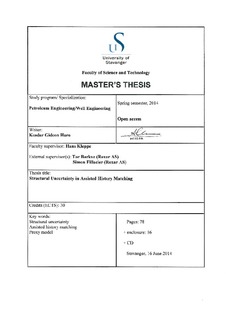| dc.description.abstract | Uncertainty in the building of a 3D geo-model process is a result of our limited knowledge of the actual condition (Bratvold, R. B. and Begg, S. H., 2010). Many interpretations, analogues, estimations and simplifications are made when one get into the subsurface matters. Besides, the information gathered to reduce uncertainty has its own limitation, for example scale and resolution (Barkve, 2013). In the volumetric oil in place calculation, reservoir geometry and spatial properties uncertainty have been accounted to yield probabilistic outcomes. While in reservoir simulation, deterministic single geo-model was often used. Due to different software applications used in geo-model building and reservoir simulation, only limited calibrations in spatial properties are allowed. Reservoir geometry alteration is avoided which can cause looping back to the geo-modeling process. Otherwise, trial and error of building geo-model to run simulation is inevitable. Considering reservoir study’s time and budget, a reservoir engineer would try to solve the history matching problem even with unphysical calibration to compensate impractical access to all uncertain parameters. Still, the result is bias and unreliable single model solution.
The synthetic field model used in this study has two faults. These faults positions movement are modifiers for history matching process. The number of modifiers is set to two to enable proxy model visualization in a surface plot. A combination of automated geo-model rebuilding, geo-model – reservoir simulation bridging tool and assisted history matching allows multiple solutions to be performed.
The proxy model result substitutes the traditional reservoir simulation within acceptable accuracy range which makes it reliable in structural history matching. It also provides the result within superior time which makes it practical to implement. Unphysical values in some regions of the proxy model had no accuracy implication rather than visual look of the graphs. Minimization algorithms worked very well in reducing uncertainty of production performance, oil in place and indirectly in bulk rock volume (BRV). | nb_NO |
